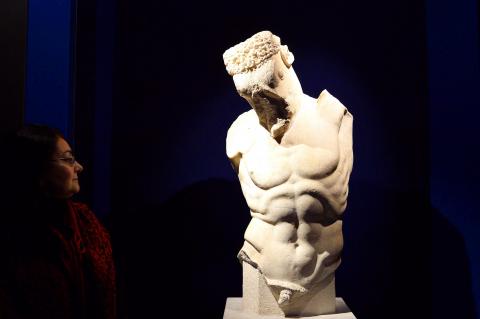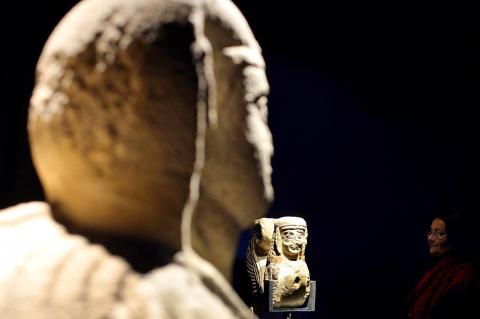Griffins, sirens and minotaurs went on display in Rome this week, for an exhibition on monsters of antiquity with Hollywood special effects experts still inspired by the classical creatures acting as consultants.
The show brought together 100 works including statues, frescoes and vases from museums around the world depicting fantastical creatures — all in a web of passages intended to resemble the minotaur’s labyrinth.
“Monsters are part of the myths of every culture, every civilization,” said Elisabetta Setari, co-curator of the exhibition with Rita Paris, director of the National Roman Museum which is hosting the show.

Photo: AFP
“They have characterized our civilization from the dawn of time until now,” said Setari, explaining that the images of monsters are still widely used today like the medusa in luxury fashion house Versace’s symbol.
The exhibits range from the Bronze Age to ancient Rome with sphinxes, gorgons, centaurs, sea dragons, hydras and a bronze chimera from the 6th century BC used on a Greek soldier’s shield.
The works are on loan from 40 museums in Italy and internationally, including the J. Paul Getty Museum and the Metropolitan Museum of Art in the United States.

Photo: AFP
There is a fine Greek vase with a multi-headed hydra from the 6th century BC from an Italian collection, as well as two 17th-century paintings — one with a medusa and the other with the flying horse Pegasus — to show the endurance of monstrous images through the centuries.
“Monsters are aggressive creatures. They are part animal so they have an animalistic force. Monsters in antiquity were above all protectors, for example of tombs where they appear on gravestones,” she said.
Hollywood heavyweights have been involved in the exhibition, which is being accompanied by a series of lectures on the influence of classical mythology on hi-tech special effects and fantasy films today.
“If we look at Hollywood and the monsters that have inspired us we can trace them all back to classical monsters,” said Scott Ross, a former business partner of George Lucas and James Cameron, who has worked on blockbusters including Terminator 2 and Titanic.
“It’s sort of like the concept of music where there are only 12 notes, it’s how you combine them together that makes a symphony,” said Ross, speaking next to a fresco of griffins in one the exhibition’s dark passageways.
Out of all the movies he has worked on, Ross said some of the ones with the most monstrous content have been Indiana Jones and Star Wars but most of all Terminator 2 which he called “a post-human vision.”
“Sea dragons used to warn sailors about the dangers of the sea. Monsters today are like robots. They are warning us about post-human humans,” he said.
Ross said the representation of monsters in films had transformed since the first Frankenstein by Edison Studios in 1910 when only make-up was used for effects.
“Nowadays it’s computer-generated imagery to the point that you can create anything,” he said, although he added that modern monsters were still “very simple.”
Another consultant on the exhibition is Shane Mahan, co-founder of “Legacy Effects” — a special effects company that has worked on Avatar and Iron Man — who also said he was inspired by ancient monsters.
“Monsters have remained with us in fairy tales but also in cinema,” said Paris, co-curator of the show, explaining they came from the battle between Zeus and Typhon — the most deadly monster of Greek mythology.
“If Typhon had won, chaos would have reigned,” she said.

“How China Threatens to Force Taiwan Into a Total Blackout” screamed a Wall Street Journal (WSJ) headline last week, yet another of the endless clickbait examples of the energy threat via blockade that doesn’t exist. Since the headline is recycled, I will recycle the rebuttal: once industrial power demand collapses (there’s a blockade so trade is gone, remember?) “a handful of shops and factories could run for months on coal and renewables, as Ko Yun-ling (柯昀伶) and Chao Chia-wei (趙家緯) pointed out in a piece at Taiwan Insight earlier this year.” Sadly, the existence of these facts will not stop the

Taiwan is one of the world’s greatest per-capita consumers of seafood. Whereas the average human is thought to eat around 20kg of seafood per year, each Taiwanese gets through 27kg to 35kg of ocean delicacies annually, depending on which source you find most credible. Given the ubiquity of dishes like oyster omelet (蚵仔煎) and milkfish soup (虱目魚湯), the higher estimate may well be correct. By global standards, let alone local consumption patterns, I’m not much of a seafood fan. It’s not just a matter of taste, although that’s part of it. What I’ve read about the environmental impact of the

It is jarring how differently Taiwan’s politics is portrayed in the international press compared to the local Chinese-language press. Viewed from abroad, Taiwan is seen as a geopolitical hotspot, or “The Most Dangerous Place on Earth,” as the Economist once blazoned across their cover. Meanwhile, tasked with facing down those existential threats, Taiwan’s leaders are dying their hair pink. These include former president Tsai Ing-wen (蔡英文), Vice President Hsiao Bi-khim (蕭美琴) and Kaohsiung Mayor Chen Chi-mai (陳其邁), among others. They are demonstrating what big fans they are of South Korean K-pop sensations Blackpink ahead of their concerts this weekend in Kaohsiung.

The captain of the giant Royal Navy battleship called his officers together to give them a first morsel of one of World War II’s most closely guarded secrets: Prepare yourselves, he said, for “an extremely important task.” “Speculations abound,” one of the officers wrote in his diary that day — June 2, 1944. “Some say a second front, some say we are to escort the Soviets, or doing something else around Iceland. No one is allowed ashore.” The secret was D-Day — the June 6, 1944, invasion of Nazi-occupied France with the world’s largest-ever sea, land and air armada. It punctured Adolf